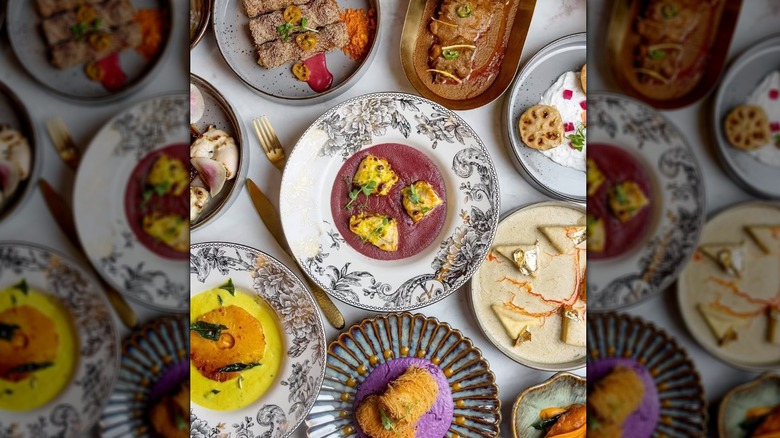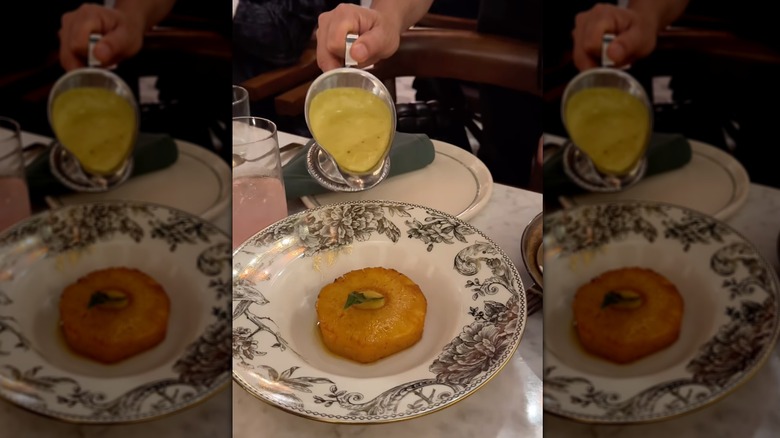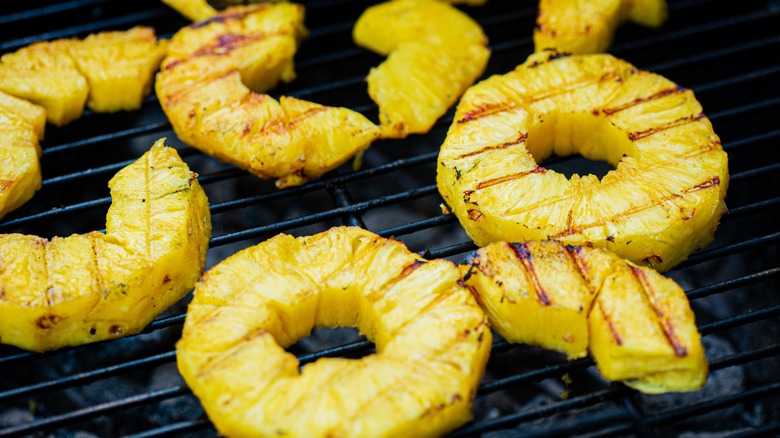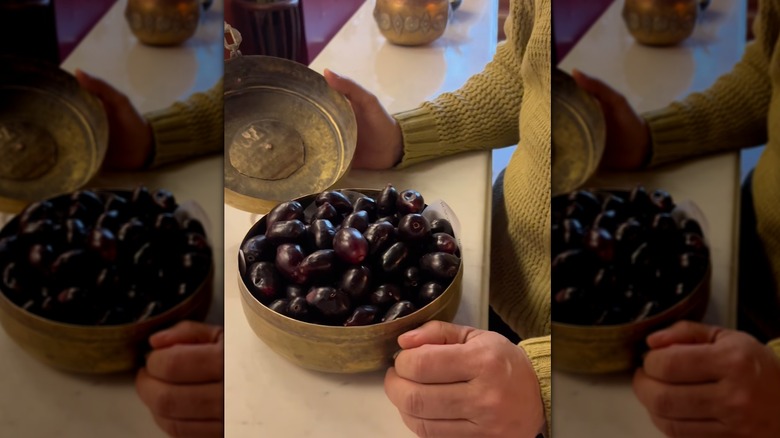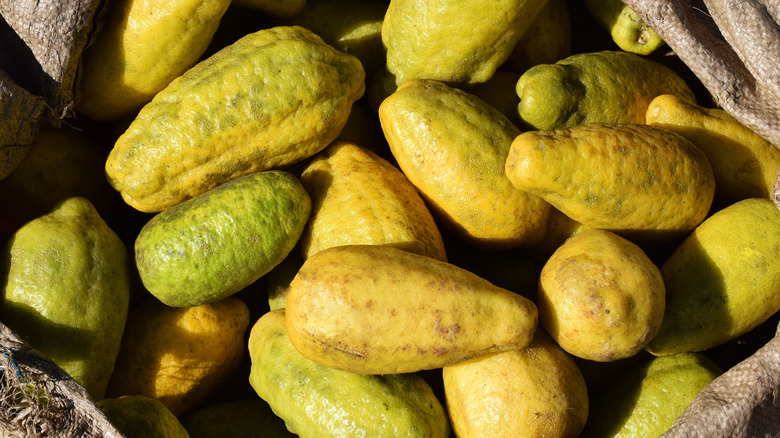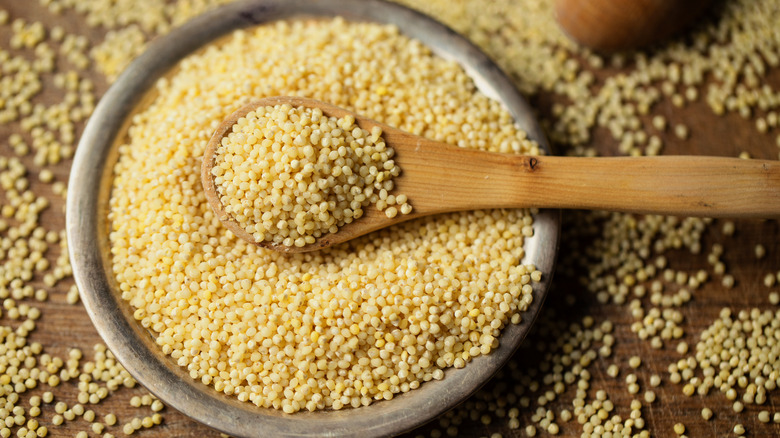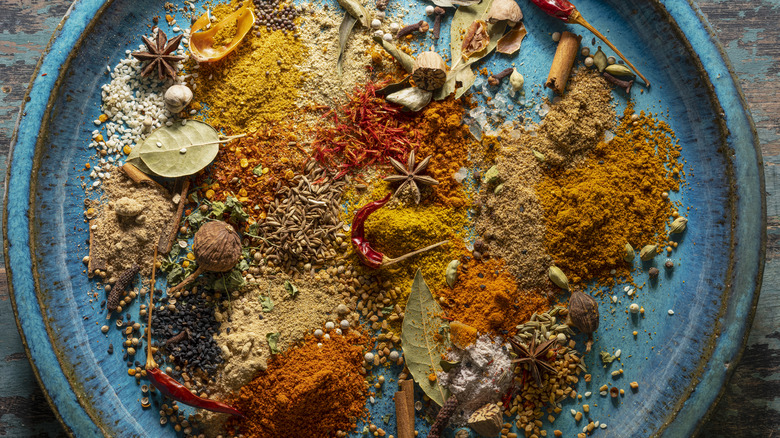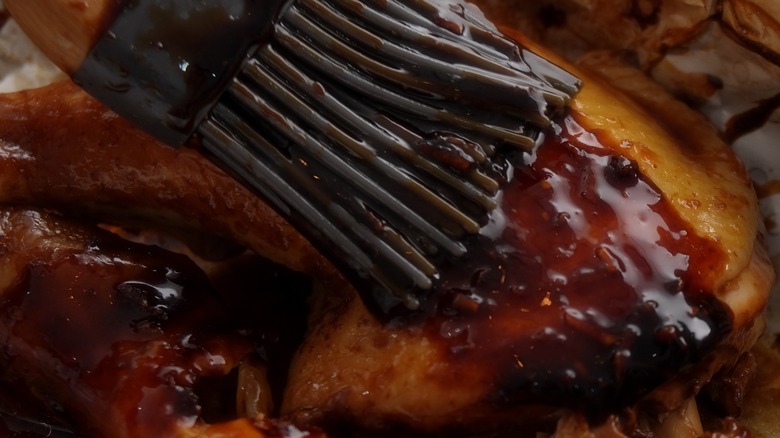MasterChef India's Vikas Khanna Shares His Favorite Underrated Fruits And Vegetables - Exclusive Interview
Author, humanitarian, filmmaker, television celebrity. Vikas Khanna has a lot of titles, but they all stem from one initial place: his passion for the culinary arts and the cuisine of his home country, India. Through much trial and tribulation, chef Vikas' first restaurant, Junoon, opened in 2010 and held long-standing Michelin awards. His newest endeavor, Bungalow, or rather its patrons, have run into difficulties of a different kind; the restaurant has one of the hardest reservations to secure in all of New York City. But, the word on the street is that the menu is both joyous and revelatory.
For Khanna, Bungalow seems to represent a hopeful new direction for Indian cuisine in the Western world; one where regional cuisines and their nuances can be experienced by their diaspora, and explored by the uninitiated. "I've seen even elders tearing down and crying," chef Vikas told Tasting Table. "As an ethnic chef, a brown chef in New York, Bungalow gives me such an amazing opportunity to represent my heritage."
Recently, we sat down with chef Vikas for an exclusive interview, where he shared his ideas about what makes Bungalow so special, as well as how Indian cuisine is currently expanding. The "MasterChef" judge also dove into some of his favorite regional ingredients and flavors to use during the year's hottest months, as well as cuisines that best utilize the flavors of the season.
The Western world is opening its eyes to regional Indian cuisine
Bungalow is one of several exciting new Indian restaurants opening in New York and it's introducing diners to a lot of regional Indian cuisines that might not be familiar to them. What do you believe is behind this surging interest in regional Indian cuisines. Is this something you think can continue beyond New York City?
I absolutely think this is a moment for Indian food. I also agree on thinking that, "would this continue?" I think it would, because I see a lot of chefs who are coming to New York or to the Western world right now, people are putting money on them. They're very classically trained in Indian cuisine. It really helps you to create a modern version of things when you're classically trained.
I've had food, Indian cuisine at its finest, outside India in the last few years. Starting with Dhamaka and Semma and what they've been doing. I just feel that it's mind-blowing for a regional cuisine restaurant, Indian restaurant, to get a Michelin star. This is all new for us and we are very proud of it and I think it's not a moment, it's a movement.
How to make pineapple the star of the plate
Speaking on the menu at Bungalow, one thing I loved is that you start the large plates with a spice roasted pineapple. I'm really curious about this recipe.
I think that is also tableside service. That's the only dish. I just wanted to elevate ... I initially thought I should do the pulled lamb as a tableside service, but I said, "we've seen that a lot." Meats are given the center stage all the time, and that's okay, we understand why; it's such a long history of French cuisine in the world. But I said, let's do a tableside service of a vegetarian dish, and that's also not a normal dish, it's a roasted pineapple.
What I love about this dish is I had it the first time on April 13, 1991. I was traveling to the South for my interview for my culinary college, and there was a chance I would never get in because I didn't speak English, so my interview didn't go well. I go to the nearby temple, which was serving free food, and they served me a curry of pineapple and coconut — spicy curry, no onions, no garlic. It had chilies, it had pineapple, it had coconut, and it had curry leaves and mustard seeds. It was so shocking for my Punjabi palate at that time. I came from the North, it hit me so hard, the possibilities of Indian cuisine.
Many times when I was doing a restaurant, I was not a hundred percent convinced what should I do with this. I wanted to keep the golden color because in that temple they used tamarind to sour the sauce. In India, pineapple is extremely sweet, not like in the Western world where you are lucky to get a sweet pineapple, where most of the pineapple is almost not even sweet, right? But, we get this intense sweet flavor pineapple, and I said, "I'm going to find a way to translate that from Krishna Temple, from the Southern India's temple cuisine, and make it into mainstream thing."
It's also a little heavier on me because we are so busy, but everybody wants me to do the tableside service for that, and I love it. That dish has a star quality because I see the faces light up the moment the people have that bite. See, it's pina colada, right? It's a match in heaven in a way, which in the Western world, that's the reference. Even Indians don't know about the dish, which makes it so exciting for me, and I love it. Every day when I have to tell the story of the dish, I keep that moment alive of me going to beg the gods, "Please get me into the college somehow."
How to grill pineapple this summer
An incredible story adds such an extra level to the dish. Do you have any quick fire tips for grilling pineapple as an entree?
Absolutely. What we do is we separately cook pineapple. We do a marination of a little bit of tamarind, red chili powder, cumin, and salt. And we get that done. But before serving, we sear it. It goes through like three stages. Before we sear it, we add a chili sugar powder to it, which has crystals of lemon. We put that powder and then we sear it on a very hot griddle and then we serve it. The sauce is so easy to make. If I tell you that, you will say, "Oh my god, you can make it in two minutes."
I do hot coconut oil, I add mustard seeds to it. It's not the Dijon mustard; these are black mustard seeds. Then we add curry leaves, we add the turmeric, we cook it for a few seconds, we add coconut milk and we add rice flour to it. So the thickening comes from rice. The moment you add a little bit of rice flour, it's dissolved in a little water so there's no lumps in it, and that's it.
Wow!
Yeah. I end this with a little bit of lemon juice because I want that tartness to be balancing that sugar caramelized top of the pineapple.
One cup of coconut milk, I add one tablespoon of rice flour. Because what happens, if you're going to thicken the rice, many people think that you can thicken the coconut milk. It does not thicken. It separates. There's so much fat, it separates. The moment you start heating it up, take a whisk, add this. It's almost like adding a slurry of cornstarch to something.
On Indian summer produce
You mentioned the reason you brought the pineapple tableside isn't to deprioritize meat, but put produce at center stage. A lot of the menu at Bungalow is vegetarian. What are some other favorite summer produce items that you like to work with? What about them inspires you?
You noticed something totally correct; our menu is more vegetarian inclined. 65% of the menu is vegetarian. If you add the desserts to it, only one dessert has egg. We only have three desserts. We've had lot of trouble ... I would say that I must have aged 10 years just getting the produce from India.
We have a drink which requires these small berries, which come only in the first two weeks of summer in India, just two weeks. We had to get the produce of the whole harvest, because I'm not going to put something on the menu which I don't have enough for at least for two weeks. By the time you promote it, by the time people are making reservations, you create awareness around it.
And this is one of the most difficult things to acquire. [Bungalow] is a first Indian restaurant, so mainstream, to serve a drink like that. It's called phalsa. These are India's sherbet berries. These are small, dark, they're almost black like blueberries, but when you cook them or you blend them, it'll turn very strong mauve color. It has been a challenge for me to bring mangoes from India twice a week. It has been a big challenge because I don't know if the dessert is going to be there in the restaurant tomorrow or not if I don't get the produce today.
Certainly.
Talking about mangoes being plucked from the farms, I monitor that, it has to come to the closest mainstream station because this is all growing in the outskirts and then getting to Mumbai or Delhi and getting them shipped in the flight with the pressure changes and temperature changes. Many mangoes don't survive. Many people don't get that, that it's like 40% of the mangoes do not make it to New York because of the temperature change.
It's like New Yorkers; we have to be high endurance power to survive this crazy city. It's not for the weak-hearted; we won't make it. But the city teaches you to be enduring, this kind of resistance from the city in many ways. When it embraces you, it embraces you wholeheartedly. That's what I feel about New York. And then it forgets about you, which is also amazing.
There are three fruits of the summer. If you speak to any Indian and I give you those names of three fruits, those little [phalsas], and there's mangoes, and there is jamun, which is, I'm sure you heard of the dessert gulab jamun, which is like ... it's not the same. These are jamuns and every time you eat it, your tongue turns black for a few minutes. That is how as kids we knew who stole it, because there will be proof on your tongue.
These are all the summer things which I had committed to my sister that I'm going to bring to America. And summer has been very hard on me; I am not kidding. Because I've spent so much time with the vendors and coordinating my deliveries of fresh produce, not coming from upstate, coming from other part of the planet.
The fruits to choose for non-alcoholic beverages
Are there other ingredients, in addition to these fruits, that you could use to make refreshing non-alcoholic beverages this time of year?
Tamarind is such a versatile ingredient. I know in Latin America they do tamarind drinks, but even in India, they use a lot of tamarind in different regions. Again, we need the regional cuisine references. See, to get a very clear perspective of what is regional cuisine, I would say that even Punjabi cuisine is regional, where I come from. But because it took the mainstream structure, we don't feel it's ethnic or it's those small pockets. Most of the first people who actually moved out of India are people from my city and my state, Punjab, up in the North. They went to London or they went to Canada. They started driving cabs or doing their jobs, saved money, were so passionate about their cuisine, put their cuisine forward. And they only knew a few dishes, and that became the template of Indian cuisine. I feel that.
That's one thing which is very interesting to observe. Now we are beyond that whole moment of just surviving as small mom and pops restaurants to bigger investment, bigger returns. That is why we want to also give diners a bigger experience, a newer experience, not to just give them their favorites, which have been passed down to us in the Western restaurant world for generations, but also to introduce them to something new. I feel that's interesting.
One drink, which is so, so unique, which I'm working so hard for those lemons and it's killing me. These are called Gondhoraj lemons. They come from Kolkata. These are an extremely long lemon. They're not round or spherical. They are very long lemons. But their rind is so delicious. I'm doing a drink; hopefully ... I don't want to jinx it because last time it happened, I got so excited, I announced it, I couldn't get the produce. But it's lemon and buttermilk.
Interesting.
Extremely amazing for summer.
And the rind, it's a sweeter rind?
Sour. So perfumey. It's like once you cut that lemon with your hand, your fingertips are going to smell of lemon for next three days.
It comes from the eastern part of India. I've seen that a lot in different states, but the ones I'm trying to get for next week, it's really been a very big pain for me. But I'm so proud and I'm putting in this effort so that ... because I also understand how many people are watching you do this, perform this thing like a theater every day after day.
Yesterday, we completed three months and it has been nothing less than pure delight. Absolutely. To represent your ancestors, to represent your heritage on this scale. And that the restaurant can evoke patriotism, I had no idea. This is a first time saying it. I think it's because of all these little things, people feel that this is not just a generic restaurant.
Consider adding grains to your pantry
What are some essential pantry staples that you like to keep on hand in your own kitchen?
I request everyone to have roasted chickpeas in their cabinet. It's very high protein, but order it without the black shell. When I have to snack, I don't have to eat anything unhealthy. I stay very far from unhealthy food for my normal diet because I also get to taste way too much of fat in my cuisine, and salts, because I have to taste so many sauces and get ready for the evening service. But roasted chanas, we call chana, are so amazing. They're gluten-free. They have no fried thing to it, but they also give you enough protein, like 20 grams in one cup, which is amazing. So you can keep it on your table side and just keep munching on them. I promise you, this is my staple in my life.
I also feel multi-grain is much more powerful than having just rice in your pantry. Most of the grains, I can be killed by saying this, most of the grains are based on the fundamentals of two portions of liquid. Which is amazing because you can get a multi-grain pack, which is better for you than eating just plain rice, for fiber, for digestion, for protein intake. And you can use, again, the same recipe for the water, but you can adjust a little extra. Some grains require more water because they're more dehydrated, but that is something as a staple, I would always keep myself ready for that.
Right now, I'm using a lot of millets. Finger, foxtail, two types I keep it in my pantry. They are easy to cook, but somehow when we see them on the grocery shelves, we feel they're going to be hard to cook or I'm going to waste time and space to buy this. Please experiment with grains. They have so much more nutrition than we think of than just consuming rice.
To work Indian flavors into your grilling repertoire, start with spice
What are some tips you have to impart more regional Indian flavors into grilling repertoires over the summer?
One thing which we are doing at Bungalow is when you get your check, you also get a small container of spice mix. I have figured a spice mix is so easy to make, but because we do it fresh, people feel it's superior. It's not; it's just been done fresh.
One thing I request people who are listening to this or reading this is that please do not grind your spices in larger quantities and keep them. You increase their surface area and after some time they lose all their scent and aroma. I think it's using a spice grinder and just not much and just grinding little bit of cumin, cardamom. I'm just telling you something so generic. Coriander seed is amazing just by itself; use that. Then you might have cinnamon powder, so you grind them and you add your cinnamon powder or red chili powder or paprika to it ... Sometimes it's easier to grind with the salt because it gives you easier leverage with the blades.
I always feel that it's so interesting that people think they cannot experiment with spices because they feel very alien to them. I feel that most of the spices are very easy to use. But keeping a small ground spice mix in your kitchen, small quantity, it's always going to help you.
As it pertains to specific regional cuisines of India, are there any that you feel are best suited for summer cooking?
I have a love-hate relationship with the summer cooking. Many parts of India, where there's a lot of heat at this time, they eat a lot of chilies to keep them cool, but it doesn't happen like that in the Western world. Thank God sriracha hot spice has landed in our kitchens here.
It's eating way too much spicy cuisine. If you look at the whole map of India, and the South is hotter than the North, but now with this whole thing with the climate, you feel the North is also getting those temperatures. But it is so amazing that these cuisines have this extreme spice. It gets you sweating, it gets your temperature lower because you sweat so much. It doesn't happen in the Western world. So it's a very difficult thing for me to answer that because I told you it's a love-hate relationship with that entire thing. Because any region which is very hot, they would add a lot of chilies to their food.
Follow up with a good glaze
Let's say that we have some readers who are interested in trying this, however, and really want to dive into that spiciness. Where might you recommend they look first?
There are a lot of sauces which are made with yogurt. Yogurt or buttermilk are extremely used during the heat, and it could be in drinks and curries, both. It could be the raitas or the dips of yogurt. It is all coming to reduce the heat, which I think it really helps because I also call raita fire extinguisher. If your palate is burning, you got to cut it off with lactose.
I do feel for grilling, a lot of people think it's all about the marination and the right spice rubs. I feel it is, but one thing which helps you even to take it further is the glazes. You can grill your meat and when you're finishing it, you got to glaze it or serve it on the side of a chutney. A small dip can actually change the entire flavor profile of that meat. A lot of the times, when I'm putting too much difficult, intensive spice mixes or rubs on meats and grilling them, a lot is lost on the grill.
In my cuisine, I have really focused on [the city of] Lucknow, where I feel the marination of the meats are amazing. We generally do two types of marination. First marination, second marination. First marination of the meat is just some acid and salt. You squeeze in your lemon juice and salt, a little bit of garlic, or vinegar, salt and garlic. You let it sit for half an hour. The second marination, you go with whatever spice flavors you want. I do feel the third addition of flavor is the fire. The fourth is the glaze.
You can actually make glazes so easily. You can even pick up your strawberry jam, which has been sitting in the refrigerator. Just put it in the pan, add some spices, turn it toward more salty textures. You glaze your meat with it. Or a preserve of apricots. I have been doing that and it has been so successful, and then you end it with a sprinkle of a spice mix on top of it. I feel that we are so obsessed with marinations that we do not understand that glazing is actually more powerful than the marination.
At Bungalow, we have a chicken where we do pomegranate molasses with cheese as a glaze. I use pomegranate as a marination, which helps it as a tenderizer. But when you're going to have that first bite and you see that glaze, I promise you, you will feel this was so much better.

